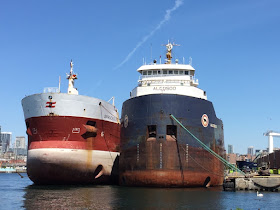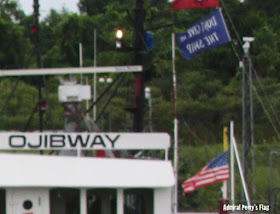 |
| Misener Transportation Postcard of SELKIRK SETTLER - Photographer Unknown |
Whenever I have a moment I'm either reading or listening to a murder mystery book and whether it's Michael Connelly's Harry Bosch, or J.A. Jance's J.P. Beaumont or Louise Penny's Chief Inspector Armand Gomache, the author at some point in the novel will have their homicide cop character say, "there's no such thing as a coincidence".
It may have appeared as a normal everyday sail past below Iroquois Locks on August 14, 2014 when I snapped the
SPRUCEGLEN as she motored upbound in ballast on her way to Thunder Bay to pick up a load of grain while the fully loaded straightdeck
OJIBWAY motored downbound to discharge her cargo of grain in Sorel, Quebec. What's unusual though is when the current CSL owned sternender was launched at Govan Shipyards in Glasgow, Scotland in 1983, she was known as the
SELKIRK SETTLER. If you're interested in Canadian history, as I am, you will know it was a very important name as it acknowledged the enduring efforts of a group Scottish immigrants that came to Canada in 1812 via Hudson's Bay to settle in the Red River Valley which is north of current day, Winnipeg, Manitoba.
Their two month crossing of the Atlantic Ocean and Hudson's Bay, and then paddling the swift rivers against the current was both long and strenuous for these future wheat farmers. To make matters worse, when arriving at their final destination in August 1812, their promised new settlements had not been completed and since the planting season had ended, the first group of European
"SELKIRK SETTLERS" may not have survived their first winter had they not been taken in by the aboriginal Saulteaux band which were descendants of the
"OJIBWAY" First Nations Peoples. Coincidence or WHAT c):-()
Whether considered a coincidence or NOT, the uniqueness here is the selection of names Misener Transportation of St. Catharines chose for their new class of gearless bulk carriers or "Saltie-Lakers" which were specifically designed to haul prairie grain to the lower St. Lawrence River grain elevators in such ports like Sorel, Quebec City and Baie Comeau while the Seaway was opened, and during the winter months, transport the grain and other products products to various overseas ports in Europe, Russia and along the Mediterranean. After the
SELKIRK SETTLER came the
CANADA MARQUIS (
http://carlzboats.blogspot.ca/2013/09/saltie-laker-canada-marquis.html) named after a specially designed grain that when it was introduced in 1911 it became known then and still today as "the best wheat variety in Canada". This high quality wheat that when baked gives the loafs more volume is grown throughout the country and continues to be exported all over the world.
The third sister which sailed under the Pioneer Shipping banner and red/orange coloured hull, was named
SASKATCHEWAN PIONEER for the many different nationalities from around the world who immigrated to Canada and settled in what is now known as Saskatchewan from 1870 to 1930 and who transformed the "the last of the west" into the "world's granary". c):-o
As Skip Gillham said in his 1989 publication of
"Canadian Fleets Along The Seaway" -
"These ships have carried grain to Cyprus, USSR, Morocco, and England. They have taken potash to France and Belgium and returned from Europe with steel for the Great Lakes...they handled winter navigation on the Baltic moving European grain from Hamburg, West Germany to Leningrad. They were now able to get a year round return on their investment instead of the ice shortened nine months on the lakes." While it appeared things were looking up for Misener's saltie-lakers, Canada's grain exports via the Great Lakes and Seaway continued to decline during the late 80's. To cut costs, the country of registry for
SELKIRK SETTLER was changed to Isle of Man in 1987. The same occurred soon after for her other saltie-laker sisters and instead of a proud Canadian flag flying from their sterns, they all flew the flag of the Isle of Man, a small island in the Irish Sea. Then in 1991 both the
SELKIRK SETTLER and
CANADA MARQUIS were sold to Federal Navigations of Montreal and while being owner or under charter with Fednav, their names were changed several times and flew a variety of other flags of convenience.
The once proud bulker named for Canada's first prairie wheat farmers was named
FEDERAL ST. LOUIS and flew the flag of the Bahamas when owned by Fednav's Detroit, Antwerp and London divisions in 1991. In the following year, she was changed to
FEDERAL FRASER and flew the flag of the Philippines, Hong Kong and Panama as the ocean trader which still visited the Great Lakes regularly, continued to be sold off from one southeast Asian owner to another while still operating under a long term charter with Fednav. In 2001 her name was changed again to simply
FRASER, a name she continued to bear when purchased by Canada Steamship Lines in October of 2002.
Reflagged Canadian, the
FRASER arrived at Quebec City in December 10th and not before leaving the next day with a load of sugar for Redpath's in Toronto, the bulk carrier was re-registered Canadian and named
SPRUCEGLEN.
Two months later, her former saltie-laker sister
CANADA MARQUIS which then sailed as the
MACKENZIE, was purchased from Fednav and renamed
BIRCHGLEN (
http://carlzboats.blogspot.ca/2012/08/saltie-laker-birchglen.html). Both vessels followed CSL's naming pattern for their gearless bulk carriers like the
PINEGLEN and
CEDARGLEN with tree motif prefix reflecting back to CSL's 1937 acquisition of Tree Line Navigation Company and their 1926 purchase of the Great Lakes Shipping Company which included the suffix
"GLEN" in their name.
 |
| Like when she arrived for her first winter layup in Toronto in December 2002, SPRUCEGLEN was probably laden with sugar when I snapped her sitting low in the water at Toronto harbour's berth 514 first last February and then again in April (both snaps above). However when I captured her again in June (below), she was sitting high in ballast and tied off to the Algoma self unloader ALGOSOO at the Section 35 dock. It's a mystery? c);-b |
Though
SPRUCEGLEN initially continued to operate deepsea during the winter months like she had done as the Misener saltie-laker,
SELKIRK SETTLER, more recently her winter layups have extended well beyond the opening of the shipping season and the St. Lawrence Seaway in the spring. Actually such was the case again this year for all of CSL's other dry bulk carrying
"GLEN's". Each laying in wait for work to come along in Thunder Bay and Montreal which is a far cry better than motoring to Turkey for dismantling which was the case for fleetmates
MAPLEGLEN and
BIRCHGLEN (the former
CANADA MARQUIS) in September 2015. c):-((
Being cut apart by a breaker's touch will just have to wait little longer as the
SPRUCEGLEN and her remaining saltie-laker fleetmates (
CEDARGLEN, PINEGLEN, and OAKGLEN) all got underway in later August to haul another bumper crop of prairie grain to lower St. Lawrence River elevators just like they were designed to do many years earlier. c):-D
As for the
ALGOSOO? Well, that's another story and it will to be told soon in an upcoming Carlz Boats. c):-((
UPDATE: January 3, 2020: The
BIRCHGLEN or former
CANADA MARQUIS continued to move grain from the Lakehead to the Lover St. Lawrence River terminals until 2015 when she was towed to Turkey for dismantling, however the third Misener
"Saltie-laker" SASKATCHEWAN PIONEER is currently operating for Lower Lakes Towing as the
KAMINISTIQUA and is wintering at Port Weller Dry Dock while having her bottom repaired from a grounding near Beauharnois by Hamilton's Heddle Marine.
 |
Downbound at Iroquois Lock - May 19, 2013. About my first rendezvous with the BIRCHGLEN check out:
https://carlzboats.blogspot.com/2012/08/saltie-laker-birchglen.html |
Here's a couple nice pics taken by Jeff Cameron of St. Catharines in 1991 of the upbound former
SELKIRK SETTLER, and then named
FEDERAL ST. LOUIS passing beneath the Garden City Skyway while approaching Lock 3. Proudly displaying the large red "
F" and partial maple leaf 🍁emblem on her stack that hull colour was still Misener Transportation
"Blue" instead of
"red" like all other FedNav bulk carriers that we see along the St. Lawrence Seaway and Great Lakes. Thank You Jeff. Great photos as always. 👍📷👍


































































